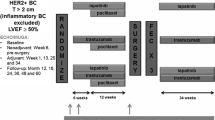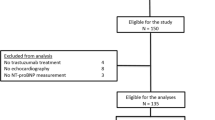Abstract
Background and objective: Anthracyclines are well established and highly efficacious antineoplastic agents for various haematopoietic and solid tumours, such as breast cancer. The main adverse effect of anthracycline therapy is cardiotoxicity. The aim of this prospective study was to determine the role of plasma levels of N-terminal pro-brain natriuretic peptide (NT-proBNP) in assessing left ventricular function in early breast cancer patients receiving adjuvant anthracycline treatment.
Methods: Thirty-three newly diagnosed breast cancer patients who received a total doxorubicin dosage of 240 mg/m2 over four treatment cycles as part of adjuvant chemotherapy after curative breast surgery were included in this study. Venous NT-proBNP levels were measured before and at the end of doxorubicin therapy. Left ventricular function was measured by echocardiography conducted 3 weeks after surgery and at the end of doxorubicin therapy.
Results: NT-proBNP levels were significantly higher in patients (n = 10) with decreased left ventricular ejection fraction (LVEF) [p = 0.02]. There was no difference in LVEF (p = 0.164) or NT-proBNP levels (p = 0.844) between the patients who had high NT-proBNP levels and those who had normal NT-proBNP levels before doxorubicin chemotherapy. None of the factors studied (breast cancer grade, estrogen receptor status, progesterone receptor status, human epidermal growth factor receptor 2 status, age) was found to be significantly related to NT-proBNP.
Conclusion: The association between higher NT-proBNP levels and reduced LVEF in asymptomatic breast cancer patients after doxorubicin administration could be an early indication of subclinical acute anthracycline cardiotoxicity. Furthermore, breast cancer patients experiencing a progressive increase in NT-proBNP levels might be in a higher risk group for acute anthracycline cardiotoxicity.


Similar content being viewed by others
References
Hitchcock-Bryan S, Gelber RD, Cassady JR, et al. The impact of induction anthracycline on long-term failure-free survival in childhood acute lymphoblastic leukemia. Med Pediatr Oncol 1986; 14: 211–5
Bonadonna G, Zambetti M, Valagussa P. Sequential or alternating doxorubicin and CMF regimens in breast cancer with more than three positive nodes: ten-year results. JAMA 1996; 273: 542–7
Fisher B, Redmond C, Wickerham DL, et al. Doxorubicin-containing regimens for the treatment of stage II breast cancer: the National Surgical Adjuvant Breast and Bowel Project experience. J Clin Oncol 1989; 7: 572–82
Ettinghausen SE, Bonow RO, Palmeri ST, et al. Prospective study of cardiomyopathy induced by adjuvant doxorubicin therapy in patients with soft-tissue sarcomas. Arch Surg 1986; 121: 1445–51
Takimoto CH. Topoisomerase interactive agents. In: De vita VT, Hellman S, Rosenberg SA, editors. Cancer principles and practice oncology. 7th ed. Philadelphia (PA): Lippincott Williams and Wilkins, 2005: 375–89
Clerico A, Passino C, Emdin M. Clinical applications in extra cardiac diseases. In: Clerico A, Emdin M, editors. Natriuretic peptides: the hormones of the heart. Milan: Springer, 2006: 133–60
Lenaz L, Page JA. Cardiotoxicity of adriamycin and related anthracyclines. Cancer Treat Rev 1976; 3: 111–20
Alexander J, Dainiak N, Berger HJ, et al. Serial assessment of doxorubicin cardiotoxicity with quantitative radionuclide angiocardiography. N Engl J Med 1979; 300: 278–83
Piver MS, Marchetti DL, Parthasarathy KL, et al. Doxorubicin hydrochloride (adriamycin) cardiotoxicity evaluated by sequential radionuclide angiocardiography. Cancer 1985; 56: 76–80
Ritchie JL, Singer JW, Thorning D, et al. Anthracycline cardiotoxicity: clinical and pathologic outcomes assessed by radionuclide ejection fraction. Cancer 1980; 46: 1109–16
Cleland JC, Goode K. Natriuretic peptides for heart failure. Fashionable? Useful? Necessary? Eur J Heart Fail 2004; 6: 253–5
McDonagh TA, Holmer S, Raymond I, et al. NT-proBNP and the diagnosis of heart failure: a pooled analysis of three European epidemiological studies. Eur J Heart Fail 2004; 6: 269–73
Costello-Boerrigter LC, Boerrigter G, Redfield MM, et al. Aminoterminal pro-B-type natriuretic peptide and B-type natriuretic peptide in the general community: determinants and detection of left ventricular dysfunction. J Am Coll Cardiol 2006; 47(2): 345–53
Davidson NC, Naas AA, Hanson JK, et al. Comparison of atrial natriuretic peptide, B-type natriuretic peptide, and N-terminal proatrial natriuretic peptide as indicators of left ventricular systolic dysfunction. Am J Cardiol 1996; 77: 828–31
Kouloubinis A, Kaklamanis L, Ziras N, et al. ProANP and NT-proBNP levels to prospectively assess cardiac function in breast cancer patients treated with cardiotoxic chemotherapy. Int J Cardiol 2007; 122: 195–201
Schiller NB, Shah PM, Crawford M, et al. Recommendations for quantitation of the left ventricle by two-dimensional echocardiography. American Society of Echocardiography Committee on Standards, Subcommittee on Quantitation of Two-dimensional Echocardiograms. J Am Soc Echocardiograph 1989; 2: 358–67
Yu HC, Sanderson JE. Different prognostic significance of right and left ventricular diastolic dysfunction in heart failure. Clin Cardiol 1999; 22: 504–12
Wood WC, Muss HB, Solin LJ, et al. Malignant tumors of the breast. In: De Vita VT, Hellman S, Rosenberg SA, editors. Cancer principles and practice oncology. 7th ed. Philadelphia (PA): Lippincott Williams and Wilkins, 2005: 1415–77
Bristow MR, Billingham ME, Mason JW, et al. Clinical spectrum of anthracycline cardiotoxicity. Cancer Treat Rep 1978; 62: 873–9
Gewirtz DA. A critical evaluation of the mechanisms of action proposed for the antitumor effects of the anthracycline antibiotics adriamycin and daunorubicin. Biochem Pharmacol 1999; 57: 727–41
Doroshow J H, Locker GY, Myers CE. Enzymatic defenses of the mouse heart against reactive oxygen metabolites: alterations produced by doxorubicin. J Clin Invest 1980; 65: 128–35
Minotti G, Menna P, Salvatorelli E, et al. Anthracyclines: molecular advances and pharmacologic developments in antitumor activity and cardiotoxicity. Pharmacol Rev 2004; 56: 185–229
Doroshow JH. Anthracyclines and anthracenediones. In: Chabner BA, Longo DL, editors. Cancer chemotherapy and bio-therapy: principles and practice. 3rd ed. Philadelphia (PA): Lippincott Williams and Wilkins, 2001: 500
Gianni L, Salvatorelli E, Minotti G. Anthracycline cardiotoxicity in breast cancer patients: synergism with trastuzumab and taxanes. Cardiovasc Toxicol 2007; 7(2): 67–71
Cowie MR, Struthers AD, Wood DA, et al. Value of natriuretic peptides in assessment of patients with possible new heart failure in primary care. Lancet 1997; 350: 1347–51
Meinardi MT, van Veldhuisen DJ, Gietema JA, et al. Prospective evaluation of early cardiac damage induced by epirubicin-containing adjuvant chemotherapy and locoregional radiotherapy in breast cancer patients. J Clin Oncol 2001; 19: 2746–53
Selwyn AP, Braunwald E. Ischemic heart disease. In: Braunwald E, Jameson Hl, Kasper D, et al., editors. Harrisons’s internal medicine. 16th ed. New York: McGraw Hill, 2434–44
Acknowledgements
No sources of funding were used to assist in the preparation of this study. The authors have no conflicts of interest that are directly relevant to the content of this study.
Author information
Authors and Affiliations
Corresponding author
Rights and permissions
About this article
Cite this article
Cil, T., Kaplan, A.M., Altintas, A. et al. Use of N-Terminal Pro-Brain Natriuretic Peptide to Assess Left Ventricular Function after Adjuvant Doxorubicin Therapy in Early Breast Cancer Patients. Clin. Drug Investig. 29, 131–137 (2009). https://doi.org/10.2165/0044011-200929020-00007
Published:
Issue Date:
DOI: https://doi.org/10.2165/0044011-200929020-00007




